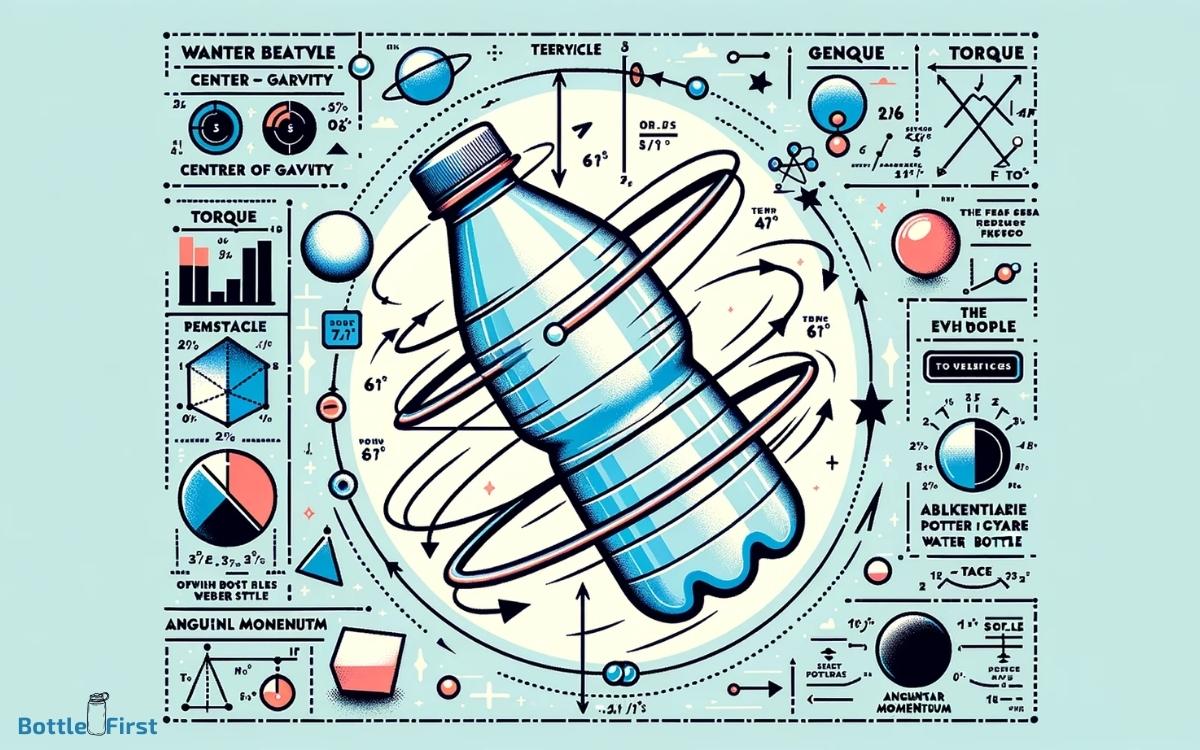What is the Science behind Water Bottle Flipping? Physics!
The science behind water bottle flipping involves understanding projectile motion, angular momentum, and the stabilization effect of water.
Water bottle flipping became a popular trend due to its simple concept but involves complex physics principles.
Successful flipping is about the right amount of water in the bottle, which should be approximately one-third full. This amount of water helps to lower the bottle’s center of mass, making it easier to control the flip.
When the bottle is thrown into the air, several factors come into play:
- Projectile Motion: The bottle follows a parabolic trajectory under the influence of gravity.
- Angular Momentum: The spin given to the bottle helps to stabilize it during its flight.
- Stabilization by Water: The water’s sloshing motion counteracts minor disturbances as the bottle falls.
For example, a bottle flipped with the right amount of spin and water will rotate smoothly around its center of mass, and land upright more often than an empty or too-full bottle.
Mastering the bottle flip involves leveraging physics principles like projectile motion and angular momentum.
The success of the flip relies on factors such as the water lowering the bottle’s center of mass, spin for stability, and the interplay of gravity and air resistance during its trajectory.
This viral sensation transforms a simple challenge into a fascinating demonstration of scientific concepts in action.

Key Takeaway
The Center of Mass
Analyzing the center of mass is crucial for understanding the physics behind water bottle flipping.
The center of mass is the point at which an object can be balanced with just one force acting directly through it, regardless of the object’s orientation.
In the case of a water bottle, the distribution of mass determines the location of its center of mass. When a bottle is flipped, it rotates around this central point. This movement is what determines whether the bottle lands upright or topples over.
Understanding the center of mass enables enthusiasts to manipulate their movements, adjusting the force and angle applied during the flip to control the bottle’s rotation and achieve the desired landing position.
Mastering the center of mass in water bottle flipping is a testament to the intricate interplay of physics and dexterity.
Understanding Projectile Motion
Understanding projectile motion is essential for comprehending the dynamics of water bottle flipping. When a bottle is flipped, it becomes a projectile, following a curved trajectory through the air.
The motion can be broken down into horizontal and vertical components, influenced by factors such as initial velocity, angle of release, and air resistance.
By understanding projectile motion, enthusiasts can predict the bottle’s flight path and optimize their flipping techniques for greater accuracy and flair.
This understanding also provides a foundation for advanced bottle-flipping tricks, where mastery of projectile motion enables performers to execute complex maneuvers with precision and consistency.
As water bottle flipping continues to evolve as a popular recreational activity, a deeper understanding of projectile motion opens up possibilities for creative and innovative variations in the art of bottle flipping.
Angular Momentum and Rotation
Angular momentum plays a crucial role in the physics behind water bottle flipping, impacting the rotation and stability of the bottle mid-air.
Understanding the principles of angular momentum and rotation is essential to grasp the science behind this viral phenomenon.
Angular Momentum Explained
Exploring the relationship between rotation and angular momentum provides insight into the physics behind water bottle flipping.
Angular momentum is a crucial concept in understanding rotational motion. It is a measure of the quantity of rotation and plays a significant role in determining the stability and behavior of rotating objects.
When a water bottle is flipped, the angular momentum changes as the bottle rotates around its axis. This change in angular momentum affects the bottle’s stability and determines whether it will successfully land upright.
Understanding the principles of angular momentum is essential for mastering the art of bottle flipping.
By manipulating the distribution of mass and the initial angular velocity, individuals can optimize the conditions for a successful bottle flip, showcasing the intriguing relationship between angular momentum and rotation.
Rotation and Stability
The relationship between rotation and stability is intricately tied to the concept of angular momentum, which governs the behavior of rotating objects with a frequency of occurrence.
- Angular momentum plays a crucial role in determining the stability of a rotating object.
- The conservation of angular momentum explains why a rotating object maintains its stability unless acted upon by an external torque.
- The distribution of mass in the object affects its rotational stability, with a more spread-out mass distribution leading to increased stability.
- The interaction between angular momentum and the object’s center of mass influences its rotational behavior and stability.
Understanding these principles is essential for comprehending the physics behind water bottle flipping, as it directly impacts the success and precision of the maneuver.
Next, let’s delve into the physics of bottle flipping.
Physics of Bottle Flipping
The interaction between angular momentum and the rotational behavior of the bottle is fundamental to understanding the physics of water bottle flipping.
When a bottle is flipped, it undergoes a complex series of motions that can be explained by the principles of angular momentum.
As the bottle rotates around its central axis, angular momentum plays a crucial role in determining its stability and final landing position.
The conservation of angular momentum governs the bottle’s rotational behavior, influencing its speed and orientation in mid-air.
Impact of Air Resistance
Air resistance significantly influences the trajectory of a flipped water bottle. Understanding its impact is crucial for mastering the art of bottle flipping.
Here are four key points to consider:
- Trajectory Alteration: Air resistance can cause the bottle to deviate from its intended path, making it essential to account for this force when flipping.
- Fluid Dynamics: Exploring the complex interactions between the bottle and the surrounding air can lead to insights on how to manipulate air resistance to achieve desired flipping outcomes.
- Optimization Opportunities: By studying air resistance, innovators can develop new bottle designs or flipping techniques that minimize its effects, potentially leading to more consistent and impressive flips.
- Scientific Experimentation: Researching the impact of air resistance on bottle flipping can inspire educational experiments and further our understanding of physics in a fun and engaging way.
Conservation of Energy
The concept of conservation of energy is fundamental to understanding the physics of water bottle flipping.
It involves the dynamics of energy transfer, the interplay between potential and kinetic energy, and the demonstration of the conservation law.
These points are essential in unraveling the scientific principles behind the seemingly simple act of flipping a water bottle.
Energy Transfer Dynamics
An understanding of the energy transfer dynamics, specifically the conservation of energy, is crucial when analyzing the science behind water bottle flipping.
To comprehend the intricate dynamics at play, consider the following:
- Potential energy: The initial potential energy of the water bottle is converted into kinetic energy as it is flipped into the air.
- Kinetic energy: The bottle gains kinetic energy as it moves upwards, reaches its peak, and then descends.
- Conservation of energy: Throughout the flipping process, energy is neither created nor destroyed, but rather transformed from potential to kinetic and back.
- Energy transfer: The transfer of energy from the thrower’s hand to the bottle and then to the surrounding air is a fascinating aspect of energy dynamics.
This understanding of energy transfer dynamics sets the stage for analyzing the interplay between potential and kinetic energy in water bottle flipping.
Potential and Kinetic Energy
In analyzing the science behind water bottle flipping, the interplay between potential and kinetic energy, governed by the principle of conservation of energy, is a fundamental aspect to consider.
When a water bottle is held upright, it possesses potential energy due to its position relative to the ground. As the bottle is flipped, this potential energy is converted into kinetic energy, the energy of motion.
The conservation of energy principle dictates that the total energy in the system remains constant, meaning that as potential energy decreases, kinetic energy increases, and vice versa.
Understanding this interplay is crucial for predicting the bottle’s behavior during flipping and landing.
Harnessing this knowledge allows for the development of innovative techniques to control and manipulate energy dynamics, ultimately enhancing the art and science of water bottle flipping.
Conservation Law Demonstration
Demonstrating the conservation of energy principle, the interplay between potential and kinetic energy in water bottle flipping exemplifies the fundamental laws governing the transfer and transformation of energy.
Four intriguing aspects of the conservation law demonstration in water bottle flipping are:
- Potential to Kinetic Energy Conversion: The initial potential energy stored in the raised bottle cap transforms into kinetic energy as the bottle is flipped, illustrating the principle of energy conservation.
- Angular Momentum Conservation: The conservation of angular momentum during the bottle’s flight showcases the preservation of rotational energy, a key concept in energy conservation.
- Impact of Air Resistance: The demonstration highlights the effect of air resistance on energy transfer, a crucial factor in understanding conservation laws in dynamic systems.
- Conservation in Landing Impact: The conservation of energy is evident in the bottle’s landing impact, emphasizing the transformation of kinetic energy back into potential energy.
These captivating demonstrations provide a glimpse into the innovative applications of energy conservation principles in everyday activities.
Transitioning into the subsequent section, the role of friction will further elucidate the intricate dynamics of water bottle flipping.
The Role of Friction
The role of friction in water bottle flipping is essential for understanding the mechanics behind this seemingly simple yet surprisingly complex phenomenon.
When a water bottle is flipped, friction between the bottle and the surface it lands on significantly affects the outcome.
The coefficient of friction between the bottle and the surface determines how the bottle grips the surface upon landing.
Too much friction may cause the bottle to stop abruptly, while too little may result in the bottle sliding uncontrollably.
Understanding and manipulating friction can thus allow for precise control over the flipping motion, enabling enthusiasts to perform increasingly intricate and impressive tricks.
Innovations in material science and surface engineering could potentially lead to the development of specialized bottles and surfaces optimized for achieving the perfect balance of friction, unlocking new possibilities in water bottle flipping.
Mastering the Release Technique
To achieve mastery of the release technique in water bottle flipping, precise timing and controlled force application are crucial elements.
Achieving the perfect release involves a combination of skill and understanding of the physics involved.
Here are four key factors to consider in mastering the release technique:
- Wrist Flick: The flick of the wrist must be timed to perfection to ensure the optimal spin is imparted to the bottle.
- Consistent Force: Applying a consistent force throughout the release is essential for achieving predictable bottle rotations.
- Angle of Release: Understanding and adjusting the angle at which the bottle is released is critical for controlling its flight path.
- Follow-Through: A smooth follow-through motion after the release helps maintain stability and control over the bottle’s rotation.
Mastering these elements is essential for consistently achieving successful water bottle flips.
Conclusion
In conclusion, the science behind water bottle flipping involves the principles of physics such as the center of mass, projectile motion, angular momentum, air resistance, conservation of energy, and the role of friction.
Mastering the release technique is essential for successful bottle flipping. For example, when a bottle is flipped, the center of mass shifts, causing the bottle to rotate and land upright due to the conservation of angular momentum.
This demonstrates the application of scientific principles in a fun and entertaining activity.






